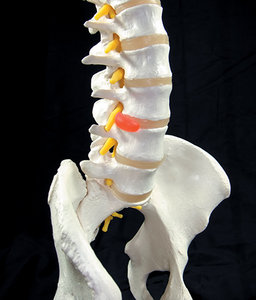Many of our patients present with lower back pain. Many times the onset is not that significant, but the pain experienced by the patient is considerable. In such cases, the patient often holds their spine rigid and guards all movement.
When evaluating the patient, a careful review of the history and description of complaints comes first and foremost.1 Understanding when and how the pain started can often give you good direction on how to pursue the case. I recall being told many times that good consult will help you understand what is going on – the subsequent palpation, exam and/or diagnostic studies should only verify what you already know.2
Most of us will default to our standard exam – palpation, observation of antalgia,3 the straight-leg raiser,4 etc. Another test that can easily be thrown into the mix is Bechterew's sitting test.5
 With the patient in a seated position, have them extend each leg one at a time. Then gently apply resistive pressure to the distal thigh. This can help localize and define back / hip / leg pain. Follow this by having the patient extend both legs. The test is positive if backache or sciatic pain is increased, or if the patient cannot perform the motion due to pain.
With the patient in a seated position, have them extend each leg one at a time. Then gently apply resistive pressure to the distal thigh. This can help localize and define back / hip / leg pain. Follow this by having the patient extend both legs. The test is positive if backache or sciatic pain is increased, or if the patient cannot perform the motion due to pain.
When the disc is involved, extending both legs will usually increase the spinal and sciatic discomfort. This test can help you differentiate a disc lesion from sciatica, adhesions, spasm or subluxation.5
Remember, the spinal cord ends at L1. Because the roots of the cauda equina run vertically within the theca, one of more of these passing caudal nerves may also be compressed. The majority of disc lesions in the lower back occur at L4-5 or L5-S1 – it is at these levels that a disc lesion will produce a syndrome of lower backache with sciatica.5
As I have shared before, no one test is all-inclusive. Bechterew's is a great test to help focus on a disc lesion and root irritation in the lower lumbar spine, but the positive finding of this test must be correlated with the rest of your examination findings.6 Also note that this test is similar to the seated straight-leg raise test and can be used to help screen for malingering or symptom magnification.7
If you elicit pain with Bechterew's, you are obligated to test further to define the source of the patient's complaints. Remember when performing the test to always note where the pain goes. Is it in the back, the buttock or the leg? Does it go down to the knee or foot? Does it cause tension or pulling up into the neck?8 Such notes are invaluable when documenting your patient's complaints and the extent of the irritation.
References
- Briggs DR. "Take the Time to Listen." Dynamic Chiropractic, Jan. 29, 2010.
- From the teachings of my good friend and mentor, Dr. Phil Paone, Palmer College.
- Briggs DR. "The Leaning Low Back." Dynamic Chiropractic, Nov. 19, 2007.
- Briggs DR. "The Straight Leg Raise Test." Dynamic Chiropractic, May 8, 2006.
- Evans RC. Illustrated Essentials in Orthopedic Physical Assessment. St. Louis, MO: Mosby; 1994.
- Briggs DR. "Some Lumbar Differentials." Dynamic Chiropractic, Dec. 2, 2008
- Briggs DR. "The Pain of Symptom Magnification." Dynamic Chiropractic, Dec. 3, 2006.
- Hammer W. "Use of the Straight-Leg Test for Upper-Extremity Involvement." Dynamic Chiropractic, Nov. 17, 1997.
Click here for more information about Douglas R. Briggs, DC, Dipl. Ac. (IAMA), DAAPM, EMT.





